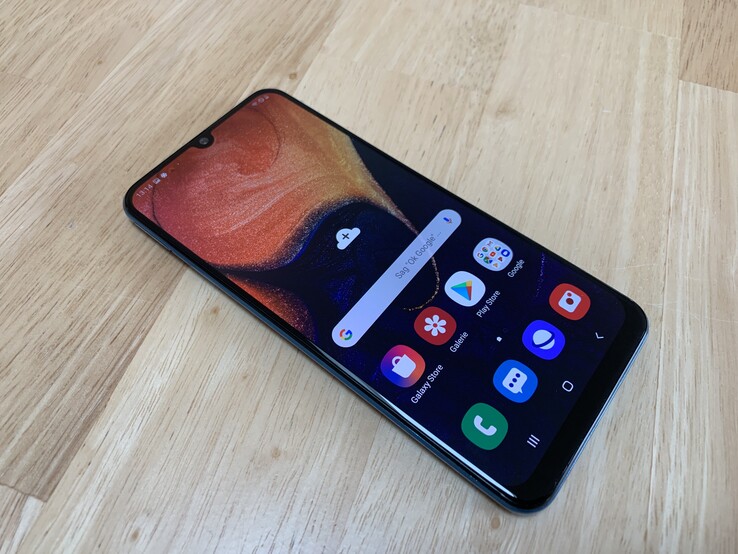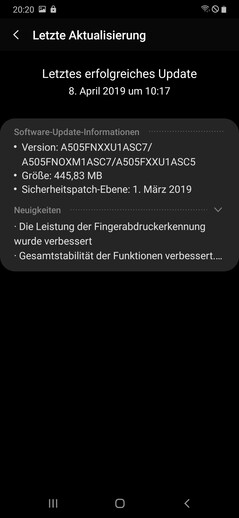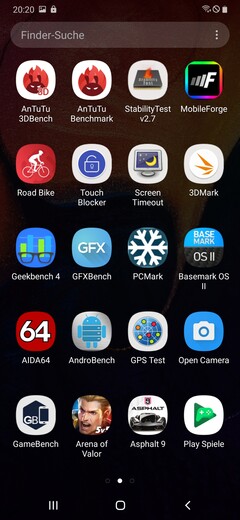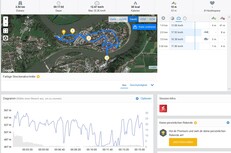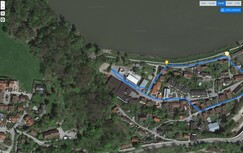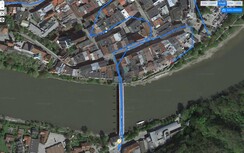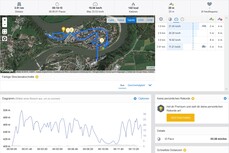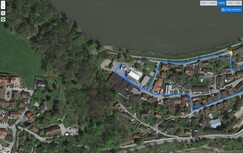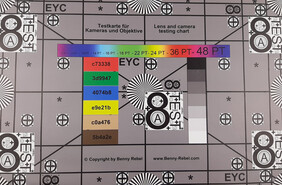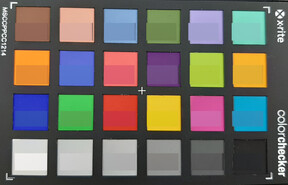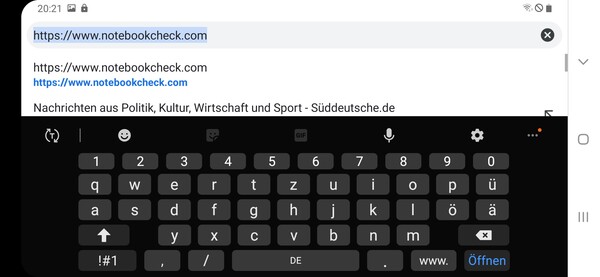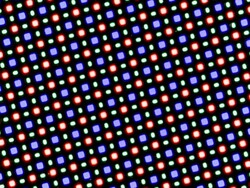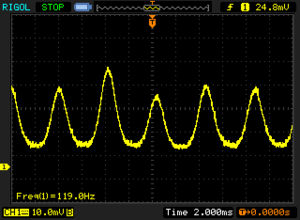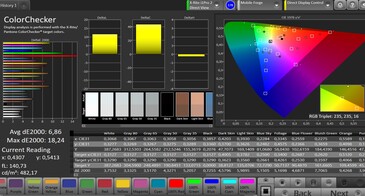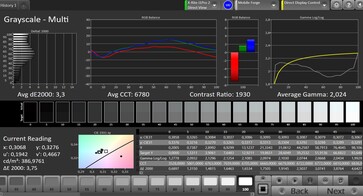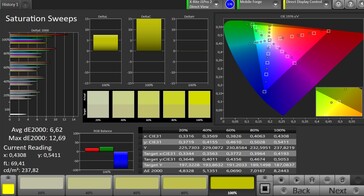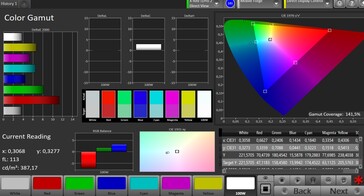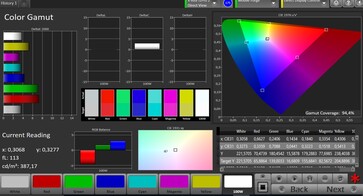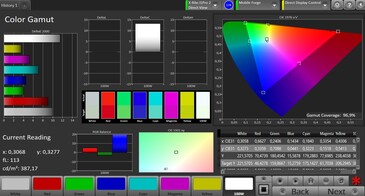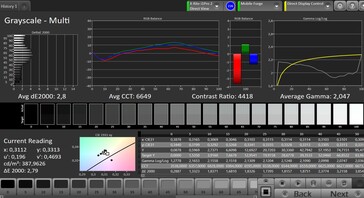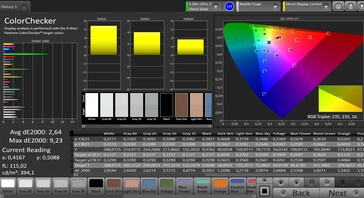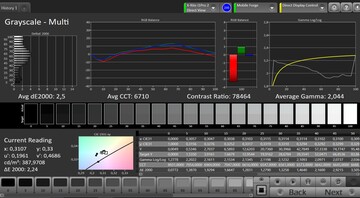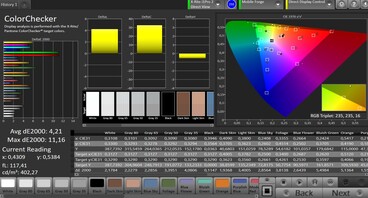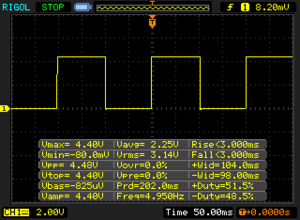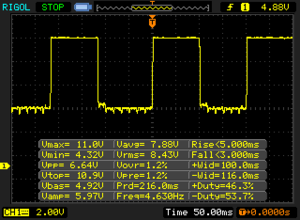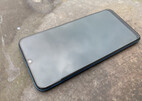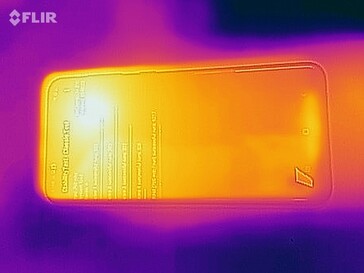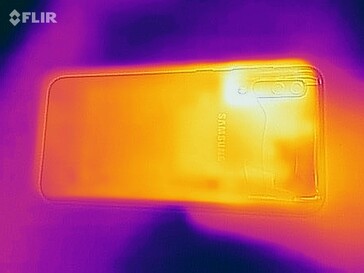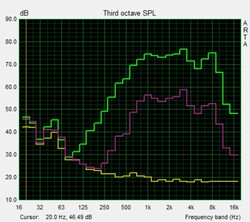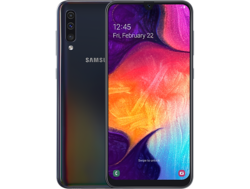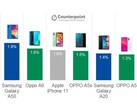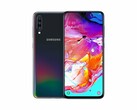Samsung Galaxy A50 Smartphone Review
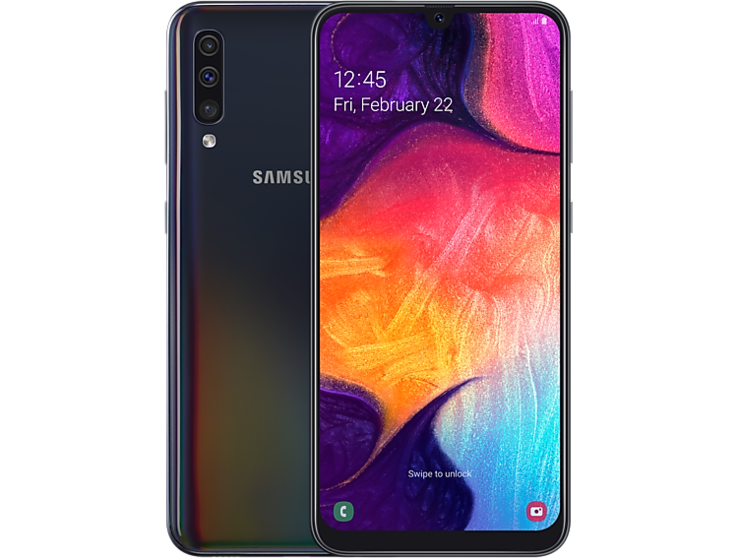
The Galaxy A series sits between the Galaxy J and Galaxy S series as Samsung’s midrange devices. The Galaxy A series currently contains the A70, A50, A40 and A20E, which means that the Galaxy A50 is effectively the midrange of the midrange.
The A50’s standout feature is its three rear-facing cameras that should excite photo enthusiasts who are operating on a budget. The device retails for 349 Euros (~$392), a classic price for a midrange smartphone, and it features a 6.4-inch “Infinity-U” display”, which is Samsung’s marketing term for what other manufacturers call a waterdrop notch that contains the front-facing camera. The A50 packs an in-screen fingerprint sensor too and comes in a choice of colours.
We have chosen to compare the A50 against other comparably priced midrange smartphones including its effective predecessor, the Galaxy A7 (2018). Our other comparison devices include the Motorola Moto G7 Plus, Nokia 7.1 and the Xiaomi Mi 9. Please keep in mind that the latter costs approximately 100 Euros (~$112) more than our review unit does at the time of testing. Likewise, the Moto G7 Plus is slightly cheaper than the A50.
Case
The fact that the A50 is a more modern smartphone than its predecessor becomes abundantly clear when looking at the display. Samsung has equipped the A50 with a display that has noticeably smaller bezels than the Galaxy A7 (2018), which the company calls an Infinity-U display. This is rather erroneous marketing though because the A50 has a notched display that borders the front-facing camera rather one that has a hole cut out of it for the camera like the Galaxy S10 series has with its Infinity O displays.
Samsung covers the back of the A50 with glass, which it has given a highly polished and almost metallic finish. The back glass is interrupted by the rear-facing camera housing, the LED flash and the Samsung logo. The A50 currently comes in a choice of black, blue, coral and white. Samsung colours the back glass and frame for all but the white model, which has a silver frame. All models have black bezels.
The A50 weighs 2 g less than the Galaxy A7 (2018), which will feel practically identical in hand. Our review unit is lighter than all but the Xiaomi Mi 9 of our comparison devices too. The A50 is well built and sturdy, nonetheless. The area around the rear-facing cameras creaks quietly when we try to flex the device, but it is impervious to our attempts no matter how hard we apply pressure with our hands. Moreover, we cannot get the display to deform even when we press hard on the front of the device. Gaps between materials are even and tight, although the top and lower edges of the screen are a bit rough, for some reason. Other than that minor blemish, the A50 is a well-made device.
Connectivity
The A50 comes with 128 GB of UFS 2.1 flash storage and 4 GB of RAM. The former is much faster than the eMMC storage that other OEMs are still using in their midrange smartphones, like Sony with its Xperia 10. Please see the Performance section of this review for a more detailed look at the A50’s UFS 2.1 storage.
The Galaxy A series has moved onto USB Type-C ports, which is nice to see. The one in the A50 operates at the slower USB 2.0 standard rather than USB 3.1 as some modern flagships do. However, Samsung has preserved the headphone jack, which is something that the A50 has over most flagships released in the last 18 months.
The A50 supports up to 512-GB microSD cards too and can read exFAT, which has no realistic file size limits like FAT32 does. We could not format our reference microSD card as internal storage, but we could store apps and data on it. You must first enable the option for this in developer options though.
Software
Samsung preinstalls Android 9.0 Pie on the A50, atop of which it adds One UI. The South Korean company has added a dark mode and has generally made its customised OS look more polished than Samsung Experience. Please see our Galaxy S10 and S10+ reviews for our full thoughts on One UI. Our review unit also had up to date security patches installed at the time of testing.
The A50 does not have a dedicated Bixby button like its Galaxy S siblings do, but you can still swipe to the right when using the default home screen to bring up the digital assistant. The Bixby home page is customisable and collates information about your most recently used apps along with other general information like the news or the weather. The A50 supports Bixby routines too, about which we have gone into depth in our Galaxy S10 and S10+ reviews.
Samsung preinstalls several third-party apps including social media and music-streaming services. These can only be disabled and not uninstalled, which is a shame. The A50 has DRM Widevine Level 1 certification though, so you can stream content from DRM-protected services like Amazon Prime Video and Netflix in glorious HD.
Communication & GPS
The A50 can operate at LTE Cat.6, which means it can theoretically achieve 300 Mb/s download and 50 Mb/s upload speeds over LTE. These are the same speeds that its predecessor could manage, but they remain on par with other midrange devices, nonetheless. The Samsung Exynos 9610 SoC supports even faster speeds over LTE, so it appears that the South Korean manufacturer has artificially limited the A50’s LTE capabilities, for some reason.
The A50 supports an adequate number of LTE bands too, which should be enough for travelling further afield than Europe. However, we would always recommend checking what LTE bands are used before going on an intercontinental trip and whether the A50 supports them. Our review unit maintained decent mobile network reception in buildings in a built-up area during our tests.
Samsung has not improved Wi-Fi speeds with the A50 compared to its predecessor either. Our test device achieves marginally better download speeds than the Galaxy A7 (2018) in iperf3 Client, but curiously it could only average 15% less than its predecessor in the upload test. Moreover, the A50 is between 6% and 11% slower than the Moto G7 Plus, although it was significantly faster than the Nokia 7.1 in the upload test. The Mi 9 is in a league of its own here and wipes the floor with the A50.
We should also point out that the A50 only retains around half the signal strength when placed around 10 metres and three walls away from our reference router. Correspondingly, webpages and content take significantly longer to load than when we tested the device in the vicinity of our router.
| Networking | |
| iperf3 transmit AX12 | |
| Xiaomi Mi 9 | |
| Samsung Galaxy A7 2018 | |
| Motorola Moto G7 Plus | |
| Samsung Galaxy A50 | |
| Nokia 7.1 | |
| iperf3 receive AX12 | |
| Xiaomi Mi 9 | |
| Nokia 7.1 | |
| Motorola Moto G7 Plus | |
| Samsung Galaxy A50 | |
| Samsung Galaxy A7 2018 | |
The A50 uses BeiDou, Galileo, Glonass and GPS for location services. Our GPS Test app result may look startling, but there appears to be a bug. Google Maps could locate us promptly and precisely during our tests, but at no point did GPS Test report that our review unit had achieved a satellite fix. Even the compass in Google Maps moved accurately, so we suspect that there is a problem with GPS Test on the A50 rather than anything more serious.
At any rate, we took the A50 on a bike ride with our trusty Garmin Edge 520 to compare their location data. The Garmin recorded us having cycled a 3.91 km route, which it plotted accurately. By contrast, the A50 claimed we cycled just 3.54 km, which is around a 10% difference. Looking at the route in detail reveals that our review unit cannot keep up with us and regularly took shortcuts to do so. In short, the A50 is accurate enough for general navigation tasks but not if you want to precisely track your location, like on a bike ride.
Telephone Features & Call Quality
Samsung preinstalls its phone app as part of One UI, which is intuitively laid out. It also offers some features that many comparable apps lack, like a search function for finding nearby restaurants.
Samsung claims that the A50 supports voice over LTE (VoLTE) on both SIM cards and Wi-Fi calling (VoWiFi). However, your carrier must provision the device for either functionality to work. The A50 will not be able to use VoLTE or VoWiFi if your carrier has not done so.
Our review unit has good call quality on both its earpiece and speakerphone. Both got very loud during our tests, while the microphones consistently captured our voice clearly with little background noise.
Cameras
The A50 has three rear-facing cameras like the Galaxy A7 (2018), and on paper not a lot has changed. The A50 has 1 MP larger front-facing and main rear-facing sensors than its predecessor, which Samsung equipped with 24 MP cameras. The main rear-facing sensor has an f/1.7 aperture just as the one in its predecessor has, and it has a 78° field of view. The high light sensitivity makes the A50 especially suited for low-light photography, which is a discipline where it excels. The secondary rear-facing camera remains an 8 MP sensor that can take wide-angle shots thanks to its 123° field of view. The A50 uses its third rear-facing camera for collecting depth of field data that it can use to create bokeh-effect shots.
Photos look a bit pale when shot in automatic mode just like its predecessor, but the main camera reproduces colours accurately and captures objects sharply. The A50 cannot compete with the cameras in flagship smartphones, but it is about a third the price of something like a Galaxy S10+. Our review unit manages to take impressive-looking photos in low light though and captures more details than the OnePlus 6T, as demonstrated in scene 3. However, the Apple iPhone XS Max exposes the scene better and manages to capture a few more details.
The A50 can record videos in up to Full HD with its main rear-facing camera. This is a restriction of the default camera app though, as third-party camera apps can record in 4K too. Videos shot with the main camera have good dynamic range, while the sensor adjusts exposure levels in changing lighting conditions quickly without being jarring.
Disappointingly, the 25 MP front-facing camera does not support autofocus and has a fixed focus instead. This means that you must carefully position the camera to get objects or your face in focus. Otherwise, pictures will come out blurry. Hence, the A50 is not a selfie specialist. Dynamic range, colours and details are decent, although it is not as good as the main sensor in low-light conditions.
In short, the A50 has a good selection of cameras for a midrange smartphone. However, we cannot notice any difference in quality between the photos it produces and those captured by its predecessor unless we look closely.
We also subjected our review unit to further camera tests under controlled lighting conditions. The A50 does a rather underwhelming job of reproducing the ColorChecker Passport reference colours, which it typically overexposes. Moreover, while our test chart looks sharp overall and the coloured elements stand out from the black and grey areas, the main camera struggles to reproduce fine details and structures like lines. These often are noticeably frayed and have jagged edges.
Accessories & Warranty
The A50 comes with a USB cable, a SIM tool, various documents and a set of headphones. Samsung also sells two cases for the device, which it markets as the “Gradation Cover” and “Wallet Flip Cover”. The former currently comes in black, pink or violet and costs around 20 Euros (~$22), and the wallet cover comes in black or white and retails for almost 30 Euros (~$34). The wallet covers also have contrasting inner colours.
The A50 comes with 24 months manufacturer’s warranty, although Samsung limits this to 12 months for the battery. Please see our Guarantees, Return Policies and Warranties FAQ for country-specific information.
Input Devices & Operation
The A50 has a 10-point multitouch touchscreen that worked precisely during our tests even into the edges of the display. Incidentally, the glass covering the touchscreen has a slippery finish on which it is easy to perform multi-finger gestures or swiping movements.
Samsung preinstalls its own keyboard as the default, which worked just as well as it has on other devices running One UI that we have tested, like the Galaxy S10 series. You can always install a different keyboard should you prefer.
The A50 uses on-screen buttons for navigating around the device, but One UI also has gesture-based controls that you can enable in settings. The only hardware buttons are the volume rocker and power button, which are located on the right-hand side of the A50’s frame. The buttons are rather narrow, but they both offer precise pressure points and are easy to find when holding the device.
Samsung has equipped the A50 with an in-screen fingerprint sensor, as it has with its Galaxy S10 series. In-screens sensors take a little longer to detect fingers than conventional ones do, and it is not immediately obvious where to place your finger when the screen is off. However, the sensor in our review unit worked well in daily use and is a more elegant solution than having a large circular shaped sensor mounted on the back glass of a device.
You can also use facial recognition to unlock the A50, but it only takes a 2D capture of your face, which is not as secure as the 3D images that solutions like Apple’s FaceID use. The A50 uses its front-facing camera to identify our face, but we found the light emitted by the display meant that our review unit could recognise our face even if we were using it in a dark room. We could also outsmart the facial unlock with a photo of our face, which underlines that it is not as secure as a fingerprint, password, pattern or PIN.
Display
If you are not buying a budget Samsung phone, chances are you'll get a smartphone with an AMOLED display. The A50 is one such device, and our review unit vividly reproduces colours and gets brighter than many of its competitors. X-Rite i1Pro 2 records the display in the A50 reaching an average maximum brightness of 628 cd/m² on automatic brightness. Our comparison devices have between 7% and 16% darker displays, although all devices are roughly as evenly bright. The Moto G7 Plus is the exception here with its 85% evenly lit display. Incidentally, it is the darkest of our comparison devices too. We should point out that switching to manual brightness reduces the maximum brightness by a good 200 cd/m², but this is often the case with modern smartphones, so it is not concerning that the A50 also exhibits this behaviour.
| |||||||||||||||||||||||||
Brightness Distribution: 91 %
Center on Battery: 644 cd/m²
Contrast: ∞:1 (Black: 0 cd/m²)
ΔE ColorChecker Calman: 2.64 | ∀{0.5-29.43 Ø4.77}
ΔE Greyscale Calman: 2.5 | ∀{0.09-98 Ø5}
141.5% sRGB (Calman 2D)
Gamma: 2.024
CCT: 6649 K
| Samsung Galaxy A50 AMOLED, 2340x1080, 6.4" | Samsung Galaxy A7 2018 Super AMOLED, 2220x1080, 6" | Motorola Moto G7 Plus IPS, 2270x1080, 6.2" | Nokia 7.1 IPS, 2280x1080, 5.8" | Xiaomi Mi 9 AMOLED, 2340x1080, 6.4" | |
|---|---|---|---|---|---|
| Screen | 23% | -62% | -96% | 29% | |
| Brightness middle (cd/m²) | 644 | 570 -11% | 537 -17% | 577 -10% | 593 -8% |
| Brightness (cd/m²) | 628 | 565 -10% | 525 -16% | 550 -12% | 587 -7% |
| Brightness Distribution (%) | 91 | 93 2% | 85 -7% | 91 0% | 94 3% |
| Black Level * (cd/m²) | 0.58 | 0.36 | |||
| Colorchecker dE 2000 * | 2.64 | 1.5 43% | 6.41 -143% | 7.4 -180% | 0.9 66% |
| Colorchecker dE 2000 max. * | 9.23 | 3.6 61% | 10.86 -18% | 15 -63% | 2 78% |
| Greyscale dE 2000 * | 2.5 | 1.2 52% | 6.7 -168% | 10.2 -308% | 1.5 40% |
| Gamma | 2.024 109% | 2.07 106% | 2.099 105% | 2.29 96% | 2.27 97% |
| CCT | 6649 98% | 6504 100% | 8310 78% | 9657 67% | 6548 99% |
| Contrast (:1) | 926 | 1603 |
* ... smaller is better
Screen Flickering / PWM (Pulse-Width Modulation)
| Screen flickering / PWM detected | 119 Hz | ||
The display backlight flickers at 119 Hz (worst case, e.g., utilizing PWM) . The frequency of 119 Hz is very low, so the flickering may cause eyestrain and headaches after extended use. In comparison: 53 % of all tested devices do not use PWM to dim the display. If PWM was detected, an average of 8083 (minimum: 5 - maximum: 343500) Hz was measured. | |||
AMOLED panels can individually switch off pixels, which they do to reproduce the colour black. Hence, devices with AMOLED panels, including the A50, theoretically have 0 cd/m² black values, which helps them also achieve infinite contrast ratios. Our review unit reproduces colours crisply and subjectively the display has excellent contrast.
Samsung includes several colour modes as it does with its more expensive Galaxy S series, which allows you to tweak the display to your preferences. The “Simple” mode delivers the best colour accuracy of the profiles included, while colours look a little flat when we set the display to “Photo” mode. Correspondingly, the latter mode has higher DeltaE deviations. Overall, the A50 has comparatively good colour accuracy, but it is not quite at the level that the Galaxy A7 (2018) achieved during our tests last year. The differences in colour accuracy are minimal though and are probably imperceptible with the naked eye.
The A50 covers large areas of the AdobeRGB and DCI P3 colour spaces, while it has full sRGB colour-space coverage. Please keep in mind that CalMAN results are only indicative in this respect and are not 100% reliable. The display also gives grey tones a minor blue tint.
Display Response Times
| ↔ Response Time Black to White | ||
|---|---|---|
| 6 ms ... rise ↗ and fall ↘ combined | ↗ 3 ms rise | |
| ↘ 3 ms fall | ||
| The screen shows very fast response rates in our tests and should be very well suited for fast-paced gaming. In comparison, all tested devices range from 0.1 (minimum) to 240 (maximum) ms. » 17 % of all devices are better. This means that the measured response time is better than the average of all tested devices (20.2 ms). | ||
| ↔ Response Time 50% Grey to 80% Grey | ||
| 8 ms ... rise ↗ and fall ↘ combined | ↗ 5 ms rise | |
| ↘ 3 ms fall | ||
| The screen shows fast response rates in our tests and should be suited for gaming. In comparison, all tested devices range from 0.165 (minimum) to 636 (maximum) ms. » 19 % of all devices are better. This means that the measured response time is better than the average of all tested devices (31.6 ms). | ||
The A50 remains usable outdoors even under bright sunlight, as demonstrated by our photos below. We suggest using auto brightness where possible, but manual maximum brightness should be enough in most cases too. The screen will look slightly washed-out at any rate.
Our review unit also has great viewing angles thanks to its AMOLED display. We noticed no brightness or colour distortions even at acute viewing angles, so you should have no problems with using the A50 from practically any angle.
Performance
Samsung equips the A50 with its in-house Exynos 9610 SoC, which it manufacturers on a 10 nm FinFET process. The SoC integrates eight cores that are split across two clusters of four Cortex-A73 cores and four Cortex-A53 cores, which clock up to 2.3 GHz and 1.7 GHz, respectively.
The A50 is the first device we have seen with the Exynos 9610, and it performed remarkably well in synthetic CPU benchmarks. The Exynos 9610 scored around 20% higher than the Exynos 7885 in the Galaxy A7 (2018) and is even further ahead of the Qualcomm Snapdragon 636 that powers the Moto G7 Plus and Nokia 7.1. The Exynos 9610 is no match for the Snapdragon 855 in the Mi 9, but the former is a midrange chip while the latter currently represents the bleeding-edge of flagship chipsets.
The Exynos 9610 also integrates an ARM Mali-G72 MP3, which should deliver improved graphics performance over the ARM Mali-G71 MP2 in the Exynos 7885. The Mali-G72 MP3 supports all current APIs, so it should be future-proofed for at least a few years.
| PCMark for Android | |
| Work performance score (sort by value) | |
| Samsung Galaxy A50 | |
| Samsung Galaxy A7 2018 | |
| Motorola Moto G7 Plus | |
| Nokia 7.1 | |
| Xiaomi Mi 9 | |
| Average Samsung Exynos 9610 (n=1) | |
| Work 2.0 performance score (sort by value) | |
| Samsung Galaxy A50 | |
| Samsung Galaxy A7 2018 | |
| Motorola Moto G7 Plus | |
| Nokia 7.1 | |
| Xiaomi Mi 9 | |
| Average Samsung Exynos 9610 (n=1) | |
| GFXBench (DX / GLBenchmark) 2.7 | |
| T-Rex Onscreen (sort by value) | |
| Samsung Galaxy A50 | |
| Motorola Moto G7 Plus | |
| Nokia 7.1 | |
| Xiaomi Mi 9 | |
| Average Samsung Exynos 9610 (n=1) | |
| Average of class Smartphone (12 - 166, n=155, last 2 years) | |
| 1920x1080 T-Rex Offscreen (sort by value) | |
| Samsung Galaxy A50 | |
| Motorola Moto G7 Plus | |
| Nokia 7.1 | |
| Xiaomi Mi 9 | |
| Average Samsung Exynos 9610 (n=1) | |
| Average of class Smartphone (22 - 954, n=155, last 2 years) | |
| GFXBench 3.0 | |
| on screen Manhattan Onscreen OGL (sort by value) | |
| Samsung Galaxy A50 | |
| Motorola Moto G7 Plus | |
| Nokia 7.1 | |
| Xiaomi Mi 9 | |
| Average Samsung Exynos 9610 (n=1) | |
| Average of class Smartphone (18 - 166, n=157, last 2 years) | |
| 1920x1080 1080p Manhattan Offscreen (sort by value) | |
| Samsung Galaxy A50 | |
| Motorola Moto G7 Plus | |
| Nokia 7.1 | |
| Xiaomi Mi 9 | |
| Average Samsung Exynos 9610 (n=1) | |
| Average of class Smartphone (12 - 606, n=156, last 2 years) | |
| GFXBench 3.1 | |
| on screen Manhattan ES 3.1 Onscreen (sort by value) | |
| Samsung Galaxy A50 | |
| Motorola Moto G7 Plus | |
| Nokia 7.1 | |
| Xiaomi Mi 9 | |
| Average Samsung Exynos 9610 (n=1) | |
| Average of class Smartphone (11 - 166, n=157, last 2 years) | |
| 1920x1080 Manhattan ES 3.1 Offscreen (sort by value) | |
| Samsung Galaxy A50 | |
| Motorola Moto G7 Plus | |
| Nokia 7.1 | |
| Xiaomi Mi 9 | |
| Average Samsung Exynos 9610 (n=1) | |
| Average of class Smartphone (8.4 - 413, n=156, last 2 years) | |
| AnTuTu v7 - Total Score (sort by value) | |
| Samsung Galaxy A50 | |
| Samsung Galaxy A7 2018 | |
| Motorola Moto G7 Plus | |
| Nokia 7.1 | |
| Xiaomi Mi 9 | |
| Average Samsung Exynos 9610 (n=1) | |
The A50 and the Exynos 9610 also finished second to the Mi 9 and the Snapdragon 855 in browser benchmarks. The gap between the A50 and the Galaxy A7 (2018) is smaller here than in CPU benchmarks though.
Webpages load quickly on our A50 review unit with the Chrome browser and scrolling remained smooth throughout our tests. Likewise, elaborate HTML5 websites load without issue.
| Jetstream 2 - 2.0 Total Score | |
| Average of class Smartphone (23.8 - 387, n=149, last 2 years) | |
| Xiaomi Mi 9 (Chrome 73) | |
| Speedometer 2.0 - Result 2.0 | |
| Average of class Smartphone (15.2 - 643, n=120, last 2 years) | |
| Xiaomi Mi 9 (Chrome 73.0.3683.75) | |
| Average Samsung Exynos 9610 (n=1) | |
| Samsung Galaxy A50 (Chome 73) | |
| WebXPRT 3 - Overall | |
| Average of class Smartphone (38 - 380, n=30, last 2 years) | |
| Xiaomi Mi 9 (Chrome 73.0.3683.75) | |
| Samsung Galaxy A50 (Chrome 73) | |
| Average Samsung Exynos 9610 (n=1) | |
| Samsung Galaxy A7 2018 (Chrome 70) | |
| Nokia 7.1 (Chrome 70) | |
| Motorola Moto G7 Plus | |
| Octane V2 - Total Score | |
| Average of class Smartphone (2228 - 126661, n=195, last 2 years) | |
| Xiaomi Mi 9 (Chrome 73.0.3683.75) | |
| Samsung Galaxy A50 (Chrome 73) | |
| Average Samsung Exynos 9610 (n=1) | |
| Samsung Galaxy A7 2018 (Chrome 70) | |
| Nokia 7.1 (Chrome 70) | |
| Motorola Moto G7 Plus | |
| Mozilla Kraken 1.1 - Total | |
| Motorola Moto G7 Plus | |
| Nokia 7.1 (Chrome 70) | |
| Samsung Galaxy A7 2018 (Chrome 70) | |
| Samsung Galaxy A50 (Chrome 73) | |
| Average Samsung Exynos 9610 (n=1) | |
| Xiaomi Mi 9 (Chrome 73.0.3683.75) | |
| Average of class Smartphone (257 - 28190, n=155, last 2 years) | |
* ... smaller is better
Samsung equips the A50 with UFS 2.1 flash storage, which smartphone manufacturers have been using in their flagship devices for a few years. Unfortunately, it appears that the South Korean manufacturer has used a slower variant of UFS 2.1 in the A50. The Mi 9 also has UFS 2.1 storage, but it totally wipes the floor with our review unit in AndroBench benchmarks. The A50 only excels with its sequential read speeds, which are between 40% and 50% faster than our comparison devices that have eMMC flash storage. The Moto G7 Plus and its eMMC storage even achieves higher transfer speeds than the A50 in two of the four AndroBench tests. Colour us disappointed.
Likewise, Samsung has equipped the A50 with a comparatively slow microSD card reader. Our review unit finishes bottom of our comparison table here and has much slower read speeds than the readers in the Moto G7 Plus and Nokia 7.1, despite all devices being tested with the same Toshiba Exceria Pro M501 microSD card.
| Samsung Galaxy A50 | Samsung Galaxy A7 2018 | Motorola Moto G7 Plus | Nokia 7.1 | Xiaomi Mi 9 | Average 128 GB UFS 2.1 Flash | Average of class Smartphone | |
|---|---|---|---|---|---|---|---|
| AndroBench 3-5 | -18% | 43% | -27% | 248% | 130% | 807% | |
| Sequential Read 256KB (MB/s) | 507 | 295.8 -42% | 283.6 -44% | 250.9 -51% | 666 31% | 761 ? 50% | 2248 ? 343% |
| Sequential Write 256KB (MB/s) | 192.1 | 104.9 -45% | 208.7 9% | 126 -34% | 388.3 102% | 296 ? 54% | 1887 ? 882% |
| Random Read 4KB (MB/s) | 98.9 | 84 -15% | 76.6 -23% | 44.9 -55% | 149.4 51% | 154 ? 56% | 299 ? 202% |
| Random Write 4KB (MB/s) | 18.2 | 15.45 -15% | 73.1 302% | 11.93 -34% | 165.3 808% | 130.4 ? 616% | 346 ? 1801% |
| Sequential Read 256KB SDCard (MB/s) | 73.9 ? | 78.2 ? 6% | 82.8 ? 12% | 83.5 ? 13% | 76 ? 3% | ||
| Sequential Write 256KB SDCard (MB/s) | 60.7 ? | 64.4 ? 6% | 62.1 ? 2% | 61.2 ? 1% | 59.6 ? -2% |
Games
The Exynos 9610 and its ARM Mali-G72 MP3 GPU handle all modern games with ease. We experienced no issues during our gaming tests, although frame rates do drop as low as 24 FPS in complex games like Asphalt 9: Legends when played at high graphics. Arena of Valor and Shadow Fight 3 averaged almost 60 FPS during our tests regardless of graphics levels though. We should also point out that any dropped frames usually occur when cycling through menus rather than in-game. Hence, you should have no problems with playing even the most graphically intensive titles like PUBG Mobile on the A50, albeit at around 30 FPS.
The touchscreen and associated sensors also worked perfectly in fast-paced games like Temple Run 2. The display’s smooth finish also makes it easy to interact with elements on-screen, but it is rather slippery.
Emissions
Temperature
The A50 manages its surface temperatures well when idling and never exceeded 30 °C during our tests. However, some areas of our review unit exceed 40 °C under sustained load with one area reaching a toasty 42.9 °C. In short, the A50 should only ever feel hot to the touch when it is being pushed hard.
The A50 does get hot, but at least it does not thermal throttle, as we found out in GFXBench battery tests. We ran the graphically intensive Manhattan benchmark on a loop for 30 minutes, during which our review unit maintained stable frame rates. So, the A50 will get hot when gaming, but it does not suffer a loss of performance as a result.
(±) The maximum temperature on the upper side is 42.9 °C / 109 F, compared to the average of 35.2 °C / 95 F, ranging from 21.9 to 247 °C for the class Smartphone.
(±) The bottom heats up to a maximum of 40.7 °C / 105 F, compared to the average of 34 °C / 93 F
(+) In idle usage, the average temperature for the upper side is 29.2 °C / 85 F, compared to the device average of 32.9 °C / 91 F.
Speakers
The A50 has a mono speaker that sits on the underside of the device, which reached a maximum of 85 dB(A) in our tests. The speaker delivers a decent sound, and its frequency curve is almost identical to the speaker in the Galaxy A7 (2018). Audio generally sounds balanced, and we can even hear lower mid-tones, which is impressive. In short, the speaker in the A50 is good enough for occasionally listening to music or watching videos.
We would always recommend using external speakers or headphones where possible though as they invariably offer a better listening experience. You can connect both to the device either via the 3.5 mm headphone jack or Bluetooth, and both reproduced audio cleanly and clearly throughout our tests.
Samsung Galaxy A50 audio analysis
(+) | speakers can play relatively loud (85 dB)
Bass 100 - 315 Hz
(-) | nearly no bass - on average 73.9% lower than median
(+) | bass is linear (0% delta to prev. frequency)
Mids 400 - 2000 Hz
(-) | nearly no mids - on average 73.9% lower than median
(+) | mids are linear (0% delta to prev. frequency)
Highs 2 - 16 kHz
(-) | nearly no highs - on average 73.9% lower than median
(+) | highs are linear (0% delta to prev. frequency)
Overall 100 - 16.000 Hz
(-) | overall sound is not linear (119.9% difference to median)
Compared to same class
» 89% of all tested devices in this class were better, 8% similar, 3% worse
» The best had a delta of 11%, average was 35%, worst was 134%
Compared to all devices tested
» 97% of all tested devices were better, 3% similar, 1% worse
» The best had a delta of 4%, average was 24%, worst was 134%
Samsung Galaxy A7 2018 audio analysis
(+) | speakers can play relatively loud (85.5 dB)
Bass 100 - 315 Hz
(-) | nearly no bass - on average 27.5% lower than median
(±) | linearity of bass is average (10.4% delta to prev. frequency)
Mids 400 - 2000 Hz
(+) | balanced mids - only 3.6% away from median
(+) | mids are linear (4.8% delta to prev. frequency)
Highs 2 - 16 kHz
(±) | higher highs - on average 8.2% higher than median
(+) | highs are linear (3.3% delta to prev. frequency)
Overall 100 - 16.000 Hz
(±) | linearity of overall sound is average (22.3% difference to median)
Compared to same class
» 47% of all tested devices in this class were better, 7% similar, 46% worse
» The best had a delta of 11%, average was 35%, worst was 134%
Compared to all devices tested
» 64% of all tested devices were better, 6% similar, 30% worse
» The best had a delta of 4%, average was 24%, worst was 134%
Battery Life
Power Consumption
The Exynos 9610 is a little more power-hungry than the Exynos 7885 and even the Snapdragon 855. Our review unit consumes a minimum of 0.8 W at idle and averages 1.5 W, which is around 10% to 15% more than the Galaxy A7 (2018) and the Mi 9. The Exynos 9610 consumes a lot under load too, but overall the A50 has lower power consumption than the Moto G7 Plus and the Nokia 7.1.
| Off / Standby | |
| Idle | |
| Load |
|
Key:
min: | |
| Samsung Galaxy A50 4000 mAh | Samsung Galaxy A7 2018 3300 mAh | Motorola Moto G7 Plus 3000 mAh | Nokia 7.1 3060 mAh | Xiaomi Mi 9 3300 mAh | Average Samsung Exynos 9610 | Average of class Smartphone | |
|---|---|---|---|---|---|---|---|
| Power Consumption | 10% | -11% | -7% | 16% | 0% | -10% | |
| Idle Minimum * (Watt) | 0.8 | 0.71 11% | 1.1 -38% | 1.01 -26% | 0.67 16% | 0.8 ? -0% | 0.847 ? -6% |
| Idle Average * (Watt) | 1.5 | 1.36 9% | 1.7 -13% | 2.2 -47% | 1.26 16% | 1.5 ? -0% | 1.446 ? 4% |
| Idle Maximum * (Watt) | 1.7 | 1.47 14% | 2.1 -24% | 2.25 -32% | 1.29 24% | 1.7 ? -0% | 1.63 ? 4% |
| Load Average * (Watt) | 5.9 | 5.13 13% | 5.1 14% | 3.76 36% | 3.71 37% | 5.9 ? -0% | 6.95 ? -18% |
| Load Maximum * (Watt) | 8.3 | 7.89 5% | 7.9 5% | 5.56 33% | 9.3 -12% | 8.3 ? -0% | 11.3 ? -36% |
* ... smaller is better
Battery Life
Samsung has equipped the A50 with a 4,000 mAh battery, possibly to counteract the high power consumption of the Exynos 9610. Correspondingly, our review unit has excellent battery life and lasted longer than its predecessor in all our battery life tests. The A50 averaged better runtimes than our other comparison devices too, although it finished in second place to the Moto G7 Plus or the Mi 9 in three of the four tests that we conducted.
Our review sample lasted for 11:41 hours in our practical Wi-Fi test, during which we run a script that simulates the load required to render websites. We also set the display to approximately 150 cd/m² as we do with all the devices that we test. In short, the A50 should last even a long day of constant use between charges and will operate under sustained load for nearly 6 hours before needing to be plugged in.
Our review unit takes just over 2 hours to recharge fully with the included charger.
| Samsung Galaxy A50 4000 mAh | Samsung Galaxy A7 2018 3300 mAh | Motorola Moto G7 Plus 3000 mAh | Nokia 7.1 3060 mAh | Xiaomi Mi 9 3300 mAh | |
|---|---|---|---|---|---|
| Battery runtime | -7% | -11% | -43% | -8% | |
| Reader / Idle (h) | 26.5 | 24.5 -8% | 16.4 -38% | 27.5 4% | |
| H.264 (h) | 14.5 | 13.9 -4% | 13.5 -7% | 8.5 -41% | 16.8 16% |
| WiFi v1.3 (h) | 11.7 | 10.1 -14% | 11.9 2% | 5.8 -50% | 9.1 -22% |
| Load (h) | 4.6 | 4.6 0% | 3.3 -28% | 2.6 -43% | 3.2 -30% |
Pros
Cons
Verdict
The Samsung Galaxy A50 is an excellent midrange smartphone. It draws on the successes of its predecessor, like with its triple rear-facing cameras, but it blends these with a more modern design and an improved SoC.
The A50 has few shortcomings, although its fingerprint sensor takes longer to recognise fingers and has a lower detection rate than conventional sensors do. Moreover, its GPS module is oddly inaccurate and its Wi-Fi performance on occasion was worse than its predecessor.
Great screen, long battery life, decent cameras. The Samsung Galaxy A50 delivers in all key areas and is a triumph of a midrange smartphone.
Samsung has also compromised on some areas like limiting LTE performance below what the SoC can achieve, which seems arbitrary. The inclusion of a fixed focus front-facing sensor makes little sense too.
With that said, the A50 makes real strides in other areas compared to the Galaxy A7 (2018). The Exynos 9610 is a big leap from the Exynos 7885, and it even edges out comparable Snapdragon chips. Samsung has included an approximately 20% larger battery too, which helps the A50 deliver better runtimes than its predecessor.
Overall, the Galaxy A50 would be an excellent choice for anyone looking for a smartphone that costs around 350 Euros (~$392). However, last year’s Galaxy A7 (2018) offers almost the same experience in an older design at a fraction of the cost.
Samsung Galaxy A50
- 08/31/2022 v7 (old)
Florian Schmitt


